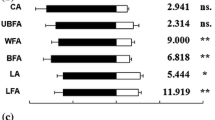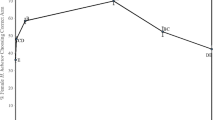Abstract
The ability of parasitoids to learn a wide range of volatiles, including ecologically relevant and novel odors, and respond favorably to the learned stimuli has been documented for various species. Comparison of odor learning in closely related species can elucidate adaptive differences in species responses to infochemicals. The present study used a Y-tube olfactometer to compare odor learning and priming of behavioral responses of two parasitoids, Cotesia marginiventris (Cresson) and Microplitis croceipes (Cresson), to four selected host-related volatile compounds which have been previously shown to elicit behavioral response in both species; trans-2-hexanal, α-pinene, cis-3-hexenyl butyrate, and (E,E)-α-farnesene. The two parasitoid species differ in their degree of specialization at the host level with M. croceipes having a more specialized host range, but otherwise represent infochemical generalist parasitoid species at the plant level. Naïve females as well as females that had been trained to associate sugar water with the test compounds were tested. Compared to naïve females, trained females of C. marginiventris showed a significant increase in behavioral response to all four tested compounds. In contrast, trained females of M. croceipes showed a significant increase in behavioral response only to α-pinene, and (E,E)-α-farnesene. Overall, the species with a wider host range, C. marginiventris showed a greater learning-induced increase in response than the species with a relatively specialized host range, M. croceipes. The results imply that animals with different ecological constraints may show variations in learning. The adaptive significance of behavioral responses as related to dietary specializations of the parasitoids is discussed.




Similar content being viewed by others
References
Baker MB (2005) Experience influences settling behavior in desert isopods, Hemilepistus reaumuri. Animal Behav 69:1131–1138
Bleeker MAK, Smid HM, Steidle JLM, Kruidhof M, van Loon JJA, Vet LEM (2006) Differences in memory dynamics between two closely related parasitoid wasp species. Animal Behav 71:1343–1350
Chen L, Fadamiro HY (2007) Differential electroantennogram response of females and males of two parasitoid species to host-related green leaf volatiles and inducible compounds. Bull Entomol Res 97:515–522
Cortesero AM, De Moraes CM, Stapel JO, Tumlinson JH, Lewis WJ (1997) Comparisons and contrasts in host foraging strategies of two larval parasitoids with different degrees of host specificity. J Chem Ecol 23:1589–1606
Dalesman S, Rundle S, Coleman RA, Cotton PA (2006) Cue association and antipredator behavior in a pulmonate snail Lymnaea stagnalis. Animal Behav 71:789–797
De Moraes CM, Lewis WJ, Pare PW, Alborn HT, Tumlinson JH (1998) Herbivore-infested plants selectively attract parasitoids. Nature 393:570–573
Dukas R, Bernays EA (2000) Learning improves growth rate in grasshoppers. Proc Natl Acad Sci USA 97:2637–2640
Eller FJ (1990) Foraging behavior of Microplitis croceipes, a parasitoid of Heliothis species. Dissertation, University of Florida, Gainesville
Farina WM, Grutter C, Diaz PC (2005) Social learning of floral odors inside the honeybee hive. Proc R Soc Lond B 272:1923–1928
Fukushima J, Kainoh Y, Honda H, Takabayashi J (2002) Learning of herbivore-induced and nonspecific plant volatiles by a parasitoid, Cotesia kariyai. J Chem Ecol 28:579–585
Geervliet JBF, Vreugdenhil AI, Dicke M, Vet LEM (1998) Learning to discriminate between infochemicals from different plant–host complexes by the parasitoids Cotesia glomerata and Cotesia rubecula (Hymenoptera: Braconidae). Entomol Exp Appl 86:241–252
Hérard F, Keller MA, Lewis WJ, Tumlinson JH (1988) Beneficial arthropod behavior mediated by airborne semiochemicals. IV. Influence of host diet on host-oriented flight chamber responses of Microplitis demolitor Wilkinson. J Chem Ecol 14:1597–1606
Hoballah ME, Turlings TCJ (2005) The role of fresh versus old leaf damage in the attraction of parasitic wasps to herbivore-induced maize volatiles. J Chem Ecol 31:2003–2018
Hoedjes KM, Marjolein Kruidhof H, Huigens ME, Dicke M, Vet LEM, Smid H (2011) Natural variation in learning rate and memory dynamics in parasitoid wasps: opportunities for converging ecology and neuroscience. Proc R Soc Lond B 278:889–897
Jaenike J (1988) Effects of early adult experience on host selection in insects: some experimental and theoretical results. J Insect Behav 1:3–15
Jalali SK, Singh SK, Ballal CR (1987) Studies on host age preference and biology of exotic parasite, Cotesia marginiventris (Cresson) (Hymenoptera: Braconidae). Entomon 12:59–62
Johnston TD (1982) Selective costs and benefits in the evolution of learning. Adv Study Behav 12:65–106
Kamil AC (1994) A synthetic approach to the study of animal intelligence. In: Real LA (ed) Behavioural mechanisms in evolutionary ecology. The University of Chicago Press, USA, pp 11–45
Lewis WJ, Burton RL (1970) Rearing Microplitis croceipes in the laboratory with Heliothis zea as host. J Econ Entomol 63:656–658
Lewis WJ, Takasu K (1990) Use of learned odours by a parasitic wasp in accordance with host and food needs. Nature 348:635–636
Lewis WJ, Tumlinson JH (1988) Host detection by chemically mediated associative learning in a parasitic wasp. Nature 331:257–259
Lewis WJ, Vet LEM, Tumlinson JH, van Lenteren JC, Papaj DR (1990) Variations in parasitoid foraging behavior: essential element of a sound biological control theory. Environ Entomol 19:1183–1193
Li Y, Dickens JC, Steiner WWM (1992) Antennal olfactory responsiveness of Microplitis croceipes (Hymenoptera: Braconidae) to cotton plant volatiles. J Chem Ecol 18:1761–1773
Loughrin JH, Manukian A, Heath RR, Tumlinson JH (1994) Diurnal cycle emission of induced volatile terpenoids by herbivore-injured cotton plants. Proc Natl Acad Sci USA 91:11836–11840
Mahometa MJ, Domjan M (2005) Classical conditioning increases reproductive success in Japanese quail, Coturnix japonica. Anim Behav 69:983–989
McCall PJ, Turlings TCJ, Loughrin J, Proveaux AT, Tumlinson JH (1994) Herbivore-induced volatile emissions from cotton (Gossypium hirsutum L.) seedlings. J Chem Ecol 20:3039–3050
Meiners T, Wäckers F, Lewis JW (2002) The effect of molecular structure on olfactory discrimination by the parasitoid Microplitis croceipes. Chem Senses 27:811–816
Meiners T, Wäckers F, Lewis JW (2003) Associative learning of complex odors in parasitoid host location. Chem Senses 28:231–236
Müller C, Collatz J, Wieland R, Steidle JLM (2006) Associative learning and memory duration in the parasitic wasp Lariophagus distinguendus. Anim Biol 56:221–232
Nafziger TD, Fadamiro HY (2011) Suitability of some farmscaping plants as nectar sources for the parasitoid wasp, Microplitis croceipes (Hymenoptera: Braconidae): effects on longevity and body nutrients. Biol Control 56:225–229
Ngumbi EN, Chen L, Fadamiro HY (2009) Comparative GC-EAD responses of a specialist (Microplitis croceipes) and a generalist (Cotesia marginiventris) parasitoid to cotton volatiles induced by two caterpillar species. J Chem Ecol 35:1009–1020
Ngumbi EN, Chen L, Fadamiro HY (2010) Electroantennogram (EAG) responses of Microplitis croceipes and Cotesia marginiventris and their lepidopteran hosts to a wide array of host-related and non host-related compounds: correlation between EAG response and degree of host specificity. J Insect Physiol 56:1260–1268
Olson DM, Rains GC, Meiners T, Takasu K, Tertuliano M, Tumlinson JH, Wäckers FL, Lewis WJ (2003) Parasitic wasps learn and report diverse chemicals with unique conditional behaviors. Chem Senses 28:545–549
Poolman Simons MTT, Suverkropp BP, Vet LEM, de Moed G (1992) Comparison of learning in related generalist and specialist eucoilid parasitoids. Entom Exp Appl 64:117–124
Potting RPJ, Otten H, Vet LEM (1997) Absence of learning in the stemborer parasitoid Cotesia flavipes. Anim Behav 53:1211–1223
Rains GC, Tomberlin JK, D’Alessandro M, Lewis WJ (2004) Limits of volatile chemical detection of a parasitoid wasp Microplitis croceipes, and an electronic nose: a comparative study. Am Soc Agric Eng 47:2145–2152
Röse USR, Alborn HT, Makranczy G, Lewis WJ, Tumlinson JH (1997) Host recognition by the specialist endoparasitoid Microplitis croeipes (Hymenoptera: Braconidae): role of host- and plant-related volatiles. J Insect Behav 10:313–330
Röse USR, Lewis WJ, Tumlinson JH (1998) Specificity of systemically released cotton volatiles as attractants for specialist and generalist parasitic wasps. J Chem Ecol 24:303–319
SAS Institute (2007) JMP 7.0.1. Statistical discovery software. SAS Institute Statistical Analysis System, Cary
Segura DF, Viscarret MM, Carabajal Paladino LZ, Ovruski SM, Cladera JL (2007) Role of visual information and learning in habitat selection by a generalist parasitoid foraging for concealed hosts. Anim Behav 74:131–142
Shorey HH, Hale RL (1965) Mass rearing of the larvae of nine noctuid species on a simple artificial medium. J Econ Entomol 58:55–68
Smid HM, Wang G, Bukovinszky T, Steidle JLM, Bleeker MAK, van Loon JA, Vet LEM (2007) Species-specific acquisition and consolidation of long-term memory in parasitic wasps. Proc R Soc Lond B 274:1539–1546
Steidle JLM, van Loon JJA (2003) Dietary specialization and infochemical use in carnivorous arthropods: testing a concept. Entomol Exp Appl 108:133–148
Takasu K, Lewis WJ (1996) The role of learning in adult food location by the larval parasitoid Microplitis croceipes. J Insect Behav 9:265–281
Takasu K, Lewis WJ (2003) Learning of host searching cues by the larval parasitoid Microplitis croceipes. Entomol Exp Appl 108:77–86
Tamò C, Ricard I, Held M, Davison AC, Turlings TCJ (2006) A comparison of naïve and conditioned responses of three generalist endoparasitoids of lepidopteran larvae to host-induced plant odors. Anim Biol 56:205–220
Tomberlin JK, Tertuliano M, Rains G, Lewis WJ (2005) Conditioned Microplitis croceipes Cresson (Hymenoptera: Braconidae) detect and respond to 2,4-DNT: development of a biological sensor. J Forensic Sci 50:1187–1190
Turlings TCJ, Wackers FL, Vet LEM, Lewis WJ, Tumlinson JH (1993) Learning of host-finding cues by hymenopterous parasitoids. In: Papaj DR, Lewis AC (eds) Insect learning: ecological and evolutionary perspectives. Chapman and Hall, New York, pp 51–78
Vet LEM, Dicke M (1992) Ecology of infochemical use by natural enemies in a tritrophic context. Ann Rev Entomol 37:141–172
Vet LEM, Groenewold AW (1990) Semiochemicals and learning in parasitoids. J Chem Ecol 16:3119–3135
Vet LEM, Lewis WJ, Papaj DR, van Lenteren JC (1990) A variable-response model for parasitoid foraging behavior. J Insect Behav 3:471–490
Vet LEM, Sokolowski MB, MacDonald DE, Snellen H (1993) Responses of a generalist and a specialist parasitoid (Hymenoptera: Eucoilidae) to drosophid larval kairomones. J Insect Behav 6:615–624
Vet LEM, Lewis WJ, Cardé RT (1995) Parasitoid foraging and learning. In: Cardé RT, Bell WJ (eds) Chemical ecology of insects, 2nd edn. Chapman and Hall, London, pp 65–101
Wäckers FL, Bonifay C, Lewis JW (2002) Conditioning of appetitive behavior in the Hymenopteran parasitoid Microplitis croceipes. Entomol Exp Appl 103:135–138
Whitman DW, Eller FJ (1992) Orientation of Microplitis croceipes (Hymenoptera: Braconidae) to green leaf volatiles: dose–response curves. J Chem Ecol 18:1743–1753
Woody DR, Mathis A (1995) Acquired recognition of chemical stimuli from an unfamiliar predator: associative learning by adult newts, Nolophthalmus viridescens. Copeia 4:1027–1031
Xue HJ, Egas M, Yang XK (2007) Development of a positive preference–performance relationship in an oligophagous beetle: adaptive learning? Entomol Exp Appl 125:119–124
Acknowledgments
We thank Prithwiraj Das, and Jennea Ollie for help with parasitoid rearing. We thank Paul Conner for designing the Y-tube stand. This research was funded by a National Science Foundation (NSF) Grant (Award Number: 0641621) to HYF.
Author information
Authors and Affiliations
Corresponding author
Rights and permissions
About this article
Cite this article
Ngumbi, E., Jordan, M. & Fadamiro, H. Comparison of associative learning of host-related plant volatiles in two parasitoids with different degrees of host specificity, Cotesia marginiventris and Microplitis croceipes . Chemoecology 22, 207–215 (2012). https://doi.org/10.1007/s00049-012-0106-x
Received:
Accepted:
Published:
Issue Date:
DOI: https://doi.org/10.1007/s00049-012-0106-x




